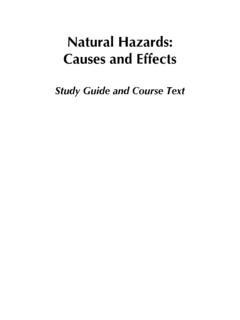Transcription of Earth Processes and Natural Hazards O - Higher Education
1 2/10/07 4:06 PM Page 131. PART TWO. Earth Processes and Natural Hazards O. ur focus in Part 2 turns to the major learn all we can about Natural Processes and Natural Hazards : an introduction to Hazards so that effects on human society may be hazardous Processes (Chapter 5), Earth - minimized; and 3) human population increase and quakes, including tsunamis (Chapter 6), changing land use are greatly increasing the threat volcanic activity (Chapter 7), flooding (Chapter 8), of loss of life and property to Natural Hazards . landslides (Chapter 9), coastal Processes , including Of particular importance is the recognition of loca- hurricanes (Chapter 10 ) , and impacts of asteroids tions where hazardous Processes are going to or comets (Chapter 11).
2 The purpose is not to occur and their Natural or human-induced return provide extensive amounts of detailed informa- period (time between events). We will learn that tion concerning these Natural Processes that we the environmentally preferred adjustment to define as Hazards but to focus on the basics Natural Hazards is environmental planning to involved and the environmental concerns result- avoid those locations where the Hazards are most ing from interactions between people and Natural likely to occur and to zone the land appropriately. Processes and Hazards . The major principles Environmental planning involves detailed study presented are: 1) Earth is a dynamic environment, of Natural Processes and mapping of those and change resulting from Natural Processes is the Processes to produce environmental maps useful norm rather than an exception; 2) we must strive to in the planning process.
3 131. PRELIMINARY PROOFS. Unpublished Work 2008 by Pearson Education , Inc. From the forthcoming book Introduction to Environmental Geology, Fourth Edition, by Edward A. Keller, ISBN 9780132251501. To be published by Pearson Prentice Hall, Pearson Education , Inc., Upper Saddle River, New Jersey. All rights reserved. This publication is protected by Copyright and written permission should be obtained from the publisher prior to any prohibited reproduction, storage in a retrieval system, or transmission in any form or by any means, electronic, mechanical, photocopying, recording, or likewise. For information regarding permission(s), write to: Rights and Permissions Department, Pearson Education , Inc.
4 , Upper Saddle River, NJ 07458. 2/10/07 4:06 PM Page 132. F I V E. PRELIMINARY PROOFS. Unpublished Work 2008 by Pearson Education , Inc. From the forthcoming book Introduction to Environmental Geology, Fourth Edition, by Edward A. Keller, ISBN 9780132251501. To be published by Pearson Prentice Hall, Pearson Education , Inc., Upper Saddle River, New Jersey. All rights reserved. This publication is protected by Copyright and written permission should be obtained from the publisher prior to any prohibited reproduction, storage in a retrieval system, or transmission in any form or by any means, electronic, mechanical, photocopying, recording, or likewise. For information regarding permission(s), write to: Rights and Permissions Department, Pearson Education , Inc.
5 , Upper Saddle River, NJ 07458. 2/10/07 4:06 PM Page 133. Introduction to Natural Hazards Learning Objectives Natural Hazards are naturally occurring pro- cesses that may be dangerous to human life and structures. Volcanic eruptions, earthquakes, floods, and hurricanes are all examples of Natural Hazards . Human population continues to increase, and there is a need to develop environmentally sound strategies to minimize the loss of life and property damage from Hazards , especially in urban areas. The study of hazardous Processes , therefore, constitutes one of the main activities of environmental geol- ogy. The learning objectives for this chapter are Understand why increasing population and changing land use increase the threat of loss of life and property from a Natural disaster to the level of a catastrophe Know the conditions that make some Natural Earth Processes hazardous to people Understand how a Natural process that gives rise to disasters may also be beneficial to people Understand the various Natural Processes that constitute Hazards to people and property Know why history, linkages between pro- cesses, prediction.
6 And risk assessment are important in determining the threat from Natural Hazards Know how people perceive and adjust to potential Natural Hazards Know the stages of recovery following Natural disasters and catastrophes Hurricane Katrina, a giant storm Hurricane Katrina approach- ing New Orleans region aerial image. (NOAA). 133. PRELIMINARY PROOFS. Unpublished Work 2008 by Pearson Education , Inc. From the forthcoming book Introduction to Environmental Geology, Fourth Edition, by Edward A. Keller, ISBN 9780132251501. To be published by Pearson Prentice Hall, Pearson Education , Inc., Upper Saddle River, New Jersey. All rights reserved. This publication is protected by Copyright and written permission should be obtained from the publisher prior to any prohibited reproduction, storage in a retrieval system, or transmission in any form or by any means, electronic, mechanical, photocopying, recording, or likewise.
7 For information regarding permission(s), write to: Rights and Permissions Department, Pearson Education , Inc., Upper Saddle River, NJ 07458. 2/10/07 4:06 PM Page 134. 134 Chapter 5 Introduction to Natural Hazards Hurricane Katrina, Most Serious Natural CASE HISTORY Catastrophe in History Hurricane Katrina (see opening photograph) made landfall in from the river over thousands of years. They are parallel to the early evening of August 29, 2005, about 45 km (30 miles) the river channel and are Higher than the adjacent land, to the east of New Orleans. Katrina was a huge storm that providing Natural flood protection. caused serious damage up to 160 km (100 mi) from its center. As marshes and swamps were drained in lower areas, the The storm produced a storm surge (a mound of water pushed city expanded into low areas with a much greater flood onshore by the storm) of 3 to 6 meters (9 to 20 feet).
8 Much of hazard. Much of the city is in a Natural bowl and parts are a the coastline of Louisiana and Mississippi was devastated as meter or so (3 to 9 feet) below sea level (Figure ). coastal barrier islands and beaches were eroded and homes It has been known for a long time that if a large hurricane destroyed. Property damage from Hurricane Katrina and were to make a direct or near-direct hit on the city, extensive costs to rehabilitate or rebuild the area may exceed $100 bil- flooding and losses would result. The warnings were not lion, making it the most costly hurricane in the history of the completely ignored, but sufficient funds were not forthcom- United States. The number of human deaths will never be ing to maintain the levee and system of floodwalls to protect known for sure, as many bodies may have been washed out low-lying areas of the city from a large hurricane.
9 To sea or buried too deep to be found. The official number of The fact that the region is subsiding at highly variable deaths is 1,836. The hurricane and subsequent flooding set rates from 1 to 4 m (3 to 12 feet) per 100 years contributed to into motion a series of events that caused significant environ- the flood hazard. Over short periods, 50 percent to 75 percent mental consequences. Initial loss of life and property from of the subsidence in some areas is Natural , resulting from wind damage and storm surge was immense. Entire coastal geologic Processes (movement along faults) that formed the communities disappeared with their fishing industry. Gulf of Mexico and the Mississippi River As much as At first it was thought the city of New Orleans had been several meters (more than 10 feet) of subsidence has occurred spared, as the hurricane did not make a direct hit.
10 The sit- in the last 100 years, and during that period sea level has risen uation turned into a catastrophe when water from Lake about 20 cm (8 in.). The rise is due in part to global warming. Pontchartrain, north of the city and connected to the Gulf, As the Gulf water and ocean water warm, they expand, rais- flooded the city. Levees capped with walls, constructed to ing sea level. The subsidence results in part from a number of keep the water in the lake and protect low-lying parts of the human Processes including extraction of groundwater, oil, city, collapsed in two locations and water poured in. Another and gas, as well as loss of freshwater wetlands that compact levee failed on the Gulf side of the city and contributed to and sink when denied sediment from the Mississippi River.









